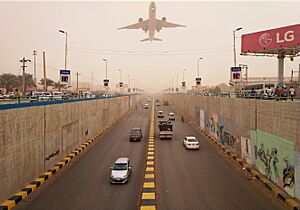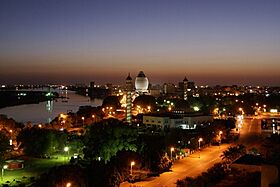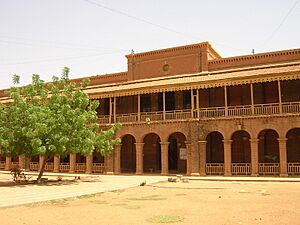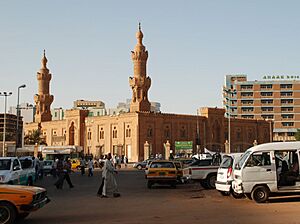Khartoum facts for kids
Quick facts for kids
Khartoum
الخرطوم
|
||
|---|---|---|
|
From top: night view of Khartoum, Khartoum Mosque, the University of Khartoum, and the El Mek Nimr Bridge.
|
||
|
||
| Nickname(s):
"Triangular Capital"
|
||
| Country | ||
| State | Khartoum | |
| Area | ||
| • Capital city | 1,010 km2 (390 sq mi) | |
| Elevation | 381 m (1,250 ft) | |
| Population
(urban 2021, all others 2013)
|
||
| • Capital city | 639,598 | |
| • Urban | 6,017,000 | |
| • Metro | 6,344,348 | |
| Demonyms | Khartoumese, Khartoumian (the latter more properly designates a Mesolithic archaeological stratum) | |
| Time zone | UTC+02:00 (Central Africa Time) | |
| • Summer (DST) | (Not Observed) | |
Khartoum (pronounced kar-TOOM) is the capital city of Sudan. It is the largest city area in Sudan, with over 6 million people living there.
Khartoum is special because it sits where two big rivers meet. These are the White Nile and the Blue Nile. The White Nile flows north from Lake Victoria, and the Blue Nile flows west from Lake Tana in Ethiopia. The place where they join is called al-Mogran, which means "The Confluence".
The city of Khartoum is actually three cities connected by bridges. These are Khartoum itself, Khartoum North, and Omdurman.
Khartoum was started in 1821 by Muhammad Ali Pasha. He was the ruler of Egypt. The city was built north of an old city called Soba. At first, it was a military outpost. But it quickly grew into an important trading center.
Later, Khartoum became the main city and capital of Sudan. In 1882, the British Empire took control of Egypt. This meant they also had a say in how Sudan was run.
During the Mahdist War, the British tried to leave Sudan. But in 1884, the city was attacked in the Siege of Khartoum. Forces loyal to the Mahdi took over the city.
In 1898, British forces took back control of Khartoum. It was the center of the Anglo-Egyptian Sudan government until 1956. In 1956, Sudan became an independent country. Khartoum was chosen as its capital.
Recently, Khartoum has seen some conflicts. In 2008, the Justice and Equality Movement fought with the Sudanese Armed Forces in the city. This was part of the War in Darfur. In 2019, there were protests and events during the Sudanese Revolution. In 2023, there was a lot of fighting in Khartoum. This was between the armed forces and the Rapid Support Forces (RSF). It affected places like Khartoum International Airport.
Khartoum is a key place for business and trade in North Africa. It has train lines connecting it to Port Sudan and El-Obeid. The city has Khartoum International Airport. A new airport is also being built. Many important places are in Khartoum. These include the National Museum of Sudan and the University of Khartoum.
Contents
What Does the Name Khartoum Mean?
The exact meaning of the name Khartoum is not fully known.
Some experts think the name comes from the Dinka language. In Dinka, words like khar-tuom or khier-tuom mean "place where rivers meet". This makes sense because Khartoum is where the White and Blue Niles join.
Another idea is that it comes from an Arabic word, khurṭūm. This word means "trunk" or "hose". It might refer to the narrow strip of land between the two Nile rivers.
Some people also think the name comes from the Arabic word qurtum. This means "safflower", a plant grown for its oil. Other ideas suggest it comes from a Nubian word, Agartum, meaning "home of Atum" (an ancient god). Or from a Beja word, hartoom, meaning "meeting".
A Look at Khartoum's History
Khartoum has a long and interesting history. It has been a center for trade and government for many years.
Early Days in the 19th Century
Khartoum was founded in 1821. It was built about 24 kilometers (15 miles) north of an ancient city called Soba. Ismail Kamil Pasha, the son of Egypt's ruler, started the city.
At first, Khartoum was a military base for the Egyptian army. But it quickly grew into a busy trading hub. It also became the main administrative center and capital of Sudan.
In 1884, forces loyal to Muhammad Ahmad began to attack Khartoum. This was known as the siege of Khartoum. The city was defended by British-led forces under General Charles George Gordon. The siege ended in 1885 when the city was captured.
In 1898, British forces led by Herbert Kitchener defeated the Mahdist forces. This happened in the Battle of Omdurman, near Khartoum.
Key Events in the 20th Century
During World War II, Italy tried to capture Khartoum. But British forces in Sudan stopped their attack.
In 1967, an important meeting of Arab leaders was held in Khartoum. This was the fourth Arab League summit.
In 1973, there was a difficult situation at the Saudi Arabian embassy. Some people held diplomats and others as hostages. Sadly, three diplomats were killed. The remaining hostages were later released.
In 1977, the first oil pipeline was built. It connected Khartoum to Port Sudan.
Another big meeting, the Organisation of African Unity summit, took place in Khartoum in 1978. Sudan was chosen to lead the organization that year.
During the 1970s and 1980s, many people came to Khartoum. They were refugees escaping conflicts in nearby countries. These included Chad, Eritrea, Ethiopia, and Uganda. Many of these refugees became part of the city's society. Others settled in large areas on the edge of the city.
Since the mid-1980s, even more refugees arrived. They came from South Sudan and Darfur. They were escaping violence from the Second Sudanese Civil War and the Darfur conflict.
In the 1990s, the government tried to move many people from the city. These people were often called "squatters". They were mostly from southern Sudan. About 425,000 people were moved to "Peace Camps" in the desert. These camps were far from food and help.
Khartoum in the 21st Century
In 2005, the leader of the Sudan People's Liberation Army, John Garang, died suddenly. This led to three days of protests in Khartoum. At least 24 people died.
In 2006, Khartoum hosted two more important summits. These were the African Union summit and another Arab League summit.
On May 10, 2008, a rebel group from Darfur attacked the city. Their goal was to overthrow the government. But the Sudanese government stopped the attack.
In October 2021, the city was shut down after a military takeover. This led to protests.
On April 15, 2023, fighting broke out in Khartoum. This was between the Sudanese Armed Forces and the RSF. Fighting happened at the presidential palace, the RSF headquarters, and the Khartoum International Airport.
City Layout and Climate
Where is Khartoum Located?
Khartoum is located where the Blue Nile and the White Nile meet. The city is mostly flat. It is about 385 meters (1,263 feet) above sea level. The Nile river then flows northeast from Khartoum.
What is Khartoum's Climate Like?
Khartoum has a very hot desert climate. This means it is dry for most of the year. About eight months have very little rain.
The long dry season has two parts. From November to February, it is warm and very dry. From March to May, it is very hot and dry. During these months, hot, dry winds blow across the region.
The rainy season is short and irregular. It lasts about one month, usually in August. This is when most of the rain falls. The average rainfall for the whole year is very low.
Khartoum is one of the hottest major cities in the world. The average temperature for the year is around 30°C (86°F). Even in winter, the average high temperature does not fall below 30°C (86°F).
People and Economy
How Many People Live in Khartoum?
| Year | Population | |
|---|---|---|
| City | Metropolitan area | |
| 1859 | 30,000 | n.a. |
| 1907 | 69,349 | n.a. |
| 1956 | 93,100 | 245,800 |
| 1973 | 333,906 | 748,300 |
| 1983 | 476,218 | 1,340,646 |
| 1993 | 947,483 | 2,919,773 |
| 2008 Census Preliminary | 3,639,598 | 5,274,321 |
The population of Khartoum has grown a lot over the years. In 1859, about 30,000 people lived in the city. By 2008, the metropolitan area had over 5 million people.
In 2019, almost 250,000 Syrians lived in Khartoum. This was about 5% of the city's total population. Many were young men who had left Syria due to conflict. Sudan was the only country that allowed travelers with Syrian passports to enter without a visa.
How Does Khartoum's Economy Work?
After a peace agreement was signed in 2005, Khartoum started many big development projects. These included new hotels, a new airport, and new bridges.
In the 21st century, Khartoum grew thanks to Sudan's oil wealth. The city center has streets lined with trees. Khartoum has the most economic activity in the country.
However, this has changed as other parts of Sudan also developed. For example, oil exploration in the south and large industrial projects elsewhere.
Khartoum has industries like printing, glass making, food processing, and textiles. Oil products are made in northern Khartoum state. This provides fuel and jobs for the city. One of Sudan's biggest oil refineries is located there.
Where Can You Shop in Khartoum?

The Souq al Arabi is Khartoum's largest outdoor market. It covers several blocks in the city center. The market has different sections, including one just for gold.
Al Qasr Street and Al Jamhoriyah Street are very popular shopping streets in Khartoum.
The Afra Mall is a modern shopping center. It has a supermarket, shops, coffee places, a bowling alley, movie theaters, and a playground for kids.
In 2011, the new Corinthia Hotel Khartoum Tower opened its hotel section and part of its food court. A shopping mall section is still being built.
Learning and Getting Around
Education in Khartoum
Khartoum is the main place for education in Sudan. There are four main levels of schooling:
- Kindergarten and day-care: This starts at age 3–4 and usually lasts 1-2 years.
- Elementary school: Children start at age 6–7. This level has 8 grades. After this, students take exams to enter high school.
- Upper secondary school and high school: This level has three grades. Students are usually 14–18 years old. They learn subjects like chemistry, biology, physics, and geography.
- Higher education: Khartoum has many universities and colleges. These include the University of Khartoum and Sudan University of Science and Technology.
Transportation in Khartoum
Khartoum is home to Khartoum International Airport. This is the biggest airport in Sudan. It is the main base for Sudan Airways. A new airport is planned for the city's outskirts.
Most transportation in Khartoum is by road. Buses and private cars are the main ways people get around. Many parts of the city are connected by privately owned buses.

Khartoum has many bridges over the Nile rivers. The Mac Nimir Bridge, the Blue Nile Road & Railway Bridge, the Cooper Bridge, and the Elmansheya Bridge cross the Blue Nile. They connect Khartoum to Khartoum North.
The Omdurman Bridge, the Victory Bridge, and the Al-Dabbasin Bridge cross the White Nile. They connect Khartoum to Omdurman. The Tuti Bridge connects Tuti Island to Khartoum. Before this bridge was built in 2008, people used water taxis to get to Tuti Island.
Khartoum also has train lines. These connect it to Wadi Halfa, Port Sudan, and El Obeid. Sudan Railways operates all these lines.
Buildings and Culture
Khartoum's Architecture
The buildings in Khartoum show its history since the 1820s. You can see Sudanese, Turkish, British, and modern styles. The architecture in Sudan is very diverse in its shapes and materials.
Since Sudan became independent, new buildings and technologies have been introduced. This has led to new and creative building designs.
Museums in Khartoum
The biggest museum in Sudan is the National Museum of Sudan. It opened in 1971. It has items from different periods of Sudanese history. You can see two ancient Egyptian temples there. These temples were moved to Khartoum when Lake Nasser was flooded.
The Republican Palace Museum opened in 2000. It is located in an old church building. It is next to the historic Presidential Palace.
The Ethnographic Museum is also in Khartoum. It is close to the Mac Nimir Bridge.
Gardens and Clubs
Khartoum has one of the oldest botanical gardens in Africa. It is called the Sudan National Botanical Garden. It is in the Mogran area of the city.
The city is home to several clubs. These include the Blue Nile Sailing Club. There are also social clubs like the German Club and the Greek Club. Khartoum also has football clubs like Al Khartoum SC and Al Ahli Khartoum.
Places of Worship
Most places of worship in Khartoum are Muslim mosques. There are also Christian churches and temples. These include St. Matthew's Cathedral, Khartoum (Catholic Church) and the Greek Orthodox Church.
Images for kids
See also
 In Spanish: Jartum para niños
In Spanish: Jartum para niños


















